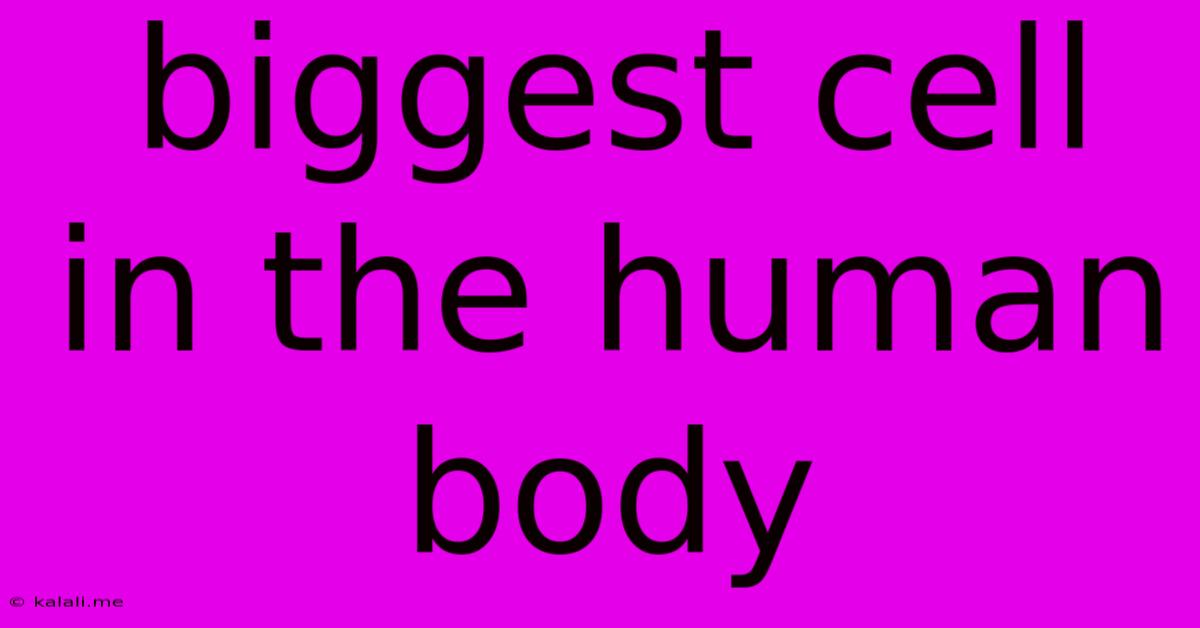Biggest Cell In The Human Body
Kalali
Jun 15, 2025 · 3 min read

Table of Contents
The Biggest Cell in the Human Body: Unveiling the Mighty Oocyte
What's the largest cell in the human body? The answer might surprise you: it's the oocyte, also known as an egg cell. This remarkable cell dwarfs all others in terms of sheer size, playing a crucial role in human reproduction. This article delves into the fascinating world of the oocyte, exploring its size, function, and significance.
The oocyte, a female gamete, is significantly larger than other human cells, easily visible to the naked eye. Its impressive size is directly related to its critical function: providing the necessary resources for the developing embryo after fertilization. Unlike most cells which focus on specific tasks, the oocyte acts as a self-contained, nutrient-rich environment for the early stages of life.
Understanding the Size and Structure of an Oocyte
While the exact size can vary slightly, a mature human oocyte typically measures approximately 100-120 micrometers in diameter. To put that in perspective, a typical human red blood cell is around 7 micrometers in diameter. This means the oocyte is roughly 15-17 times larger than a red blood cell! This substantial size allows it to hold a significant amount of cytoplasm, packed with organelles and nutrients vital for embryonic development.
The oocyte's structure is equally remarkable. It possesses a large nucleus containing the female's genetic material (23 chromosomes), a substantial amount of cytoplasm rich in RNA and proteins necessary for early embryonic growth, and a protective layer called the zona pellucida. This protective coating plays a vital role in fertilization, ensuring only one sperm can successfully penetrate and initiate the fertilization process.
The Oocyte's Role in Reproduction and Human Development
The primary function of the oocyte is to fuse with a sperm cell during fertilization. This union of genetic material forms a zygote, the single-celled precursor to a human being. The oocyte’s large size provides the developing zygote with a crucial supply of nutrients, energy, and essential building blocks needed for the initial stages of cell division and growth, before the embryo implants in the uterine wall and obtains nutrients from the mother's body.
Comparing the Oocyte to Other Large Cells
While the oocyte is undeniably the largest cell in the human body, it's important to note that other cells also achieve significant size. Nerve cells (neurons), for instance, can extend their axons over considerable distances, making their overall length impressive. However, in terms of cell body volume, the oocyte remains the undisputed champion.
Conclusion: The Oocyte – A Giant Cell with a Giant Role
The oocyte's immense size is a testament to nature's ingenuity. It highlights the extraordinary demands of human reproduction and the crucial role the oocyte plays in the very beginning of human life. Its sheer size provides the necessary resources and environment to ensure successful fertilization and the initiation of embryonic development. Understanding the oocyte's remarkable characteristics provides a deeper appreciation for the intricacies of human biology and the marvels of reproduction.
Latest Posts
Latest Posts
-
Consider The Linear Transformation T From R3 To R2 With
Jun 15, 2025
-
What Does The Following Sign Indicate
Jun 15, 2025
-
According To Dalton Atoms Cannot Be
Jun 15, 2025
-
Asthenosphere Is Part Of Which Layer Of Earth
Jun 15, 2025
-
What Is The Meaning Of Evs
Jun 15, 2025
Related Post
Thank you for visiting our website which covers about Biggest Cell In The Human Body . We hope the information provided has been useful to you. Feel free to contact us if you have any questions or need further assistance. See you next time and don't miss to bookmark.